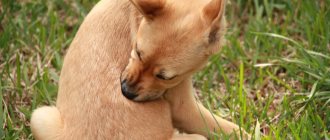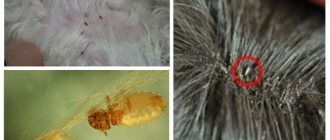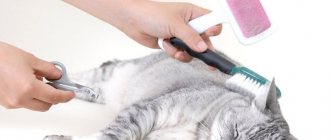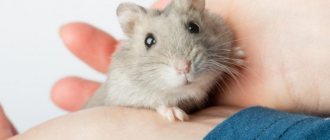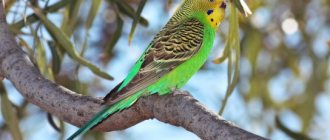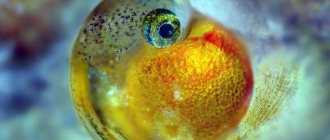/ Hamsters / Description of the hamster Karbysh
0
7066
Article rating
Domestic rodents have long won love all over the world: they are cute, funny, and cause few problems. But their wild relatives cause a lot of trouble for villagers. Hamster Karbysh - what can you expect from him?
Hamster Karbysh
Appearance
First of all, it is worth noting that this animal belongs to hamsters, being a representative of a rather harmful family. As you can see in the photo, the carbysh animal really looks like other rodents of this species.
- Its color is quite bright, even beautiful.
- The back is yellowish-brown, the belly is black, and the sides are decorated with large white spots. At the same time, the coat is short, but thick and pleasant to the touch, very soft.
- The ears are quite massive and stand out sharply on a neat head.
- The paws are quite wide with thin, sharp claws, which allows the carbysh to dig deep holes in which it will live, store supplies for the winter and raise offspring.
The karbysh is one of the largest hamsters - its weight can reach 750 grams! At the same time, the body is quite dense, compact, up to 35 centimeters long.
Content Features
To ensure a full life for black rodents at home, you first need to choose the right cage and equip it.
For a domestic rodent, a cage with dimensions of 40x30x30 cm is suitable. Use a plastic tray that is durable and environmentally friendly. Never buy a cage with a wooden pallet, as hamsters will chew through it very quickly.
You can place a decorative house in the cage, which the black animal will use as a storage place for food and for arranging a nest for the birth of babies.
You will also need a plastic drinker and two feeders - for dry and wet food.
Attach a mineral stone to the bars of the cage. The pet needs it to grind down its constantly growing teeth.
You can put a toilet in a corner of the structure and fill it with a special mixture of granules. The granular mixture eliminates all hamster feces odors. An integral attribute of housing is the wheel. During periods of activity, the animal will use it for jogging. You can install a ladder, put a couple of snags so that the black animal can climb on them.
Create a comfortable environment for your hamster
Remember, the larger and more varied you make your furry’s home, the more joyful and active his life will be. In addition, under such conditions, the black animal will not suffer from obesity, which directly affects the lifespan of the dwarf rodent.
The optimal place to install the cage is a room with good lighting, where there are no drafts or scorching sun. Install structures away from heating appliances. The ideal temperature for keeping animals is 18-20 degrees Celsius.
Lifestyle
Now you know what carbysh looks like - photos make it easy to identify this harmful rodent. This means it’s time to find out about his habits and lifestyle.
Although the karbysh is a wild animal, it still prefers to live closer to humans: in vegetable gardens, garden plots, arable land, and parks. Which is not surprising - the soil here is loose, which means it’s easy to dig a hole. But more importantly, there is always something to eat near a person.
The burrows these rodents dig are very deep and long. The depth of some reaches two meters, and the length, taking into account all the branches, is 5 meters. Here they live, winter, raise their young, and store supplies collected in the fall.
At the same time, karbysh are owners and loners. They never live in packs, preferring a solitary lifestyle, gathering in pairs only during mating. When a guest climbs into someone else's hole, an extremely brutal fight with the owner will begin, which usually ends, if not with the death of one of them, then at least with serious injuries.
They are most active at night. It is in the dark that the carbysh actively moves, feeds, and stores. During the day, he prefers to sleep in his hole, practically without leaving it, or being in close proximity to his home in order to have time to hide.
It feeds mainly on plant foods: root crops, cereals, young grass. But on occasion he does not refuse the animal. Thus, its diet is often supplemented by worms, even mice, lizards, frogs and small snakes, and insect larvae.
Loosening holes
Another way to exterminate a black pest on your site. True, it is more expensive and labor-intensive. To implement it, you will need a garden shovel, maximum effort and patience. Use a shovel to dig up rodent holes. This way you can catch live animals. It's up to you to decide what to do with them - kill them or take them away from the site.
Unfortunately, this method does not provide a 100% guarantee that you will catch all the rodents on the site. It is simply impossible to dig up the entire garden. Moreover, forest hamsters dig out entire labyrinths underground.
Habitat
The habitat of the carbysh animal, the photo of which you have already seen, is quite large. For example, in Europe it can be seen in Germany, France, Poland, Belgium, the Netherlands, Belarus - in all these countries it is protected, as it has been practically exterminated.
In our country, it lives from the northern border of the Perm Territory to Smolensk. Also, summer residents from Krasnoyarsk to Yekaterinburg often complain about it. There is quite a lot of it on the coast of the Black and Azov Seas. It is found in Kazakhstan - mainly in the east and north, where agriculture is most developed.
What harm does it cause to the garden?
Throughout the warm season, karbysh actively feeds. Moreover, he happily eats cereals, gnaws beets, radishes and carrots, destroys crops of young peas, eating sprouts. In general, he is not particularly picky, so the list of his “victims” may include cucumbers, tomatoes, pumpkins, onions, squash and much more. The animal does not shine with intelligence, so it gnaws on almost everything that seems at least somewhat appetizing to it. Often he simply spits out the food he doesn’t like, but the vegetable is already spoiled!
Danger to humans
By the way, you shouldn’t be moved by looking at a photo of a karbysh. The animal is, of course, very beautiful. But it is not just a pest, but also poses a danger to humans.
Some people, having noticed this hamster on their site, decide to catch it. And as a result, they pay with their own health. A carbysh driven into a corner behaves no less cunningly and aggressively than a rat. Moreover, these rodents are often carriers of various infections. Therefore, a bite can cause a serious illness, the cure of which will take a lot of time and effort. Keep this in mind before you attack a rodent with your bare hands. No, this is a real war. And it must be carefully planned and thought out in order to achieve the desired result.
Alarm clock repeller
This is a very effective remedy in the fight against rodents. You can make such a repeller as follows. Take two new battery-powered alarm clocks and two liter jars. At one and the other end of the garden, dig holes half a meter deep. Set alarms for 7 am and 5 pm. Place one device in each jar and place the containers in the dug holes. Cover the tops of the jars with nylon lids and sprinkle with soil.
From now on, alarm clocks will ring at the same time in the morning and evening, and will annoy rodents. After some time, forest hamsters will simply be forced to leave your area.
Fight against carbysh
The only bloodless and humane way to get rid of a rodent is to use special sound repellers. You can buy them in special stores. A person practically does not hear the sound they make, so all residents can calmly go about their business. But it has a more depressing effect on the carbysh, and as a result, after a few days the rodent leaves its usual habitat. The only negative is that this technique does not always work. The reason for this is unknown - either not all repellers are equally effective, or some animals are immune to them.
Therefore, we often have to resort to less humane methods - traps and poisons.
Traps (or large rat traps) are installed near the found exits from the holes. Be careful - one tunnel can have 4-5 exits. You can also place poisoned baits near the minks - poison can be easily purchased at any store for summer residents.
Yes, it's cruel. But in the battle for the harvest one cannot be too humane.
Trap
This is an old, proven product that is used to catch rodents both in the house and in the garden. A device must be installed at each hole. And put bait inside it - grain, nuts. In pursuit of food, the rodent falls into a trap and can no longer get out of it.
There are two types of traps on sale. Some are designed to catch rodents, others are designed to completely destroy them. Which one is better is up to you to decide.
By the way, this remedy does not always work. Forest hamsters are very cunning and dexterous. Seeing that there is a dubious device at the exit of the hole, they can bypass it, digging a hole out in another place. Therefore, traps are not considered the most effective means of controlling wild rodents.
Prevention of pest occurrence
If you do not want carbysh to start up on your site, you should get a dog or a rat-catcher cat. These animals will do an excellent job of protecting against dangerous rodents. After all, they perceive them exclusively as tasty and desirable prey.
Of course, if you choose this method, then the use of poisons is out of the question - your pets may well be poisoned by them.
How to get rid of carbysh in a summer cottage: the most effective methods
In spring, autumn, winter and summer, any gardener or gardener puts all his energy into his garden plot. They take care of plants and trees, plant, and harvest.
To achieve excellent results, they have to constantly fight pests. Pests include insects and small rodents.
Among these, it is worth paying special attention to karbysh. How to fight this animal, and who is it?
Description of the breed
The Nizhny Novgorod-Kazan hamster is the largest among its relatives - the weight of an adult reaches up to 750 g. Karbysh is a typical wild representative of hamster families. What characteristics does it appear to have?
- Bright color: black belly, reminiscent of a tuxedo, brownish-yellowish back, large white spots on the sides.
- The coat is soft and thick, short.
- The lower part of the medium-length muzzle and small, massive ears are light.
- The body is dense but compact, length – 25-35 cm.
- Short (7-8 cm), thick, bristly tail.
- Wide paws, sharp claws.
Sometimes you can find a pure black (melanistic) or piebald Karbysh. By the way, summer residents nicknamed the pest “black.” Each has a characteristic cheek pouch in which the animal carries food. In total, 10 species of common wild hamsters have been discovered to date. It is noteworthy that their appearance is influenced by their habitat: darker individuals live in the north than in the south, and western representatives are larger in size than eastern ones.
Lots of kids
Individuals reach sexual maturity at 20 weeks. Offspring are born in the spring. One litter can have from 6 to 18 cubs. If the weather is favorable, the female can give birth several times. Babies are born blind, bald and helpless, but very quickly begin to grow up and enter adult life. One male carbysh fertilizes several females at once. So you can roughly calculate how many hamsters there will soon be in one area if you don’t get rid of them, considering that they live in the wild for about 4 years.
Harm from a hamster
The black rodent began to raid households in the late nineties of the last century. There is a hypothesis that at that time the Kazan Institute conducted experiments on crossing rodents to breed a new species to obtain high-quality skins. Some of the hybrids escaped, and sanitary services did not take any measures to catch and remove them. Hamsters have taken root in temperate climates, and their reproduction rate contributed to their rapid dispersal throughout the region.
For a long time, the summer residents could not recognize which family the little black robber belonged to: the speed of his movement in the twilight did not even allow him to see the animal, let alone catch it.
When the seedling season begins, the Nizhny Novgorod hamster climbs into gardens and vegetable gardens in search of provisions. Vegetables are attacked by it: cabbage, pumpkin, carrots, beets, onions, cucumbers. This animal has its own signature style: after its attack, the seedlings look like they were cut with scissors. In summer, onions, garlic, and squash are added to Karbysh’s list. What is noteworthy is that he often does not even eat what he has bitten, but simply spits it out, which is even more offensive for the owners of the seedlings.
Pesticide
Poison against hamsters
If you have black forest hamsters in your garden, you can use bait for them. The modern market of pesticides offers a variety of poisonous agents for such pests.
From the experience of gardeners, only a few effective means have gained the most popularity:
- clerate;
- MB final;
- warat;
- rat death.
The poison is mixed with food and water. The poison is then placed near the hamster's hole. For a rodent to try this treat, it must be mixed with a grain mixture, nuts, seeds, and vegetable trimmings.
The poison should be spread in dry weather. In the rain, the poison loses its properties. Poison bait is laid out throughout the area - near the hamster holes and along the paths.
Also, do not forget that such products are dangerous to humans. When laying them around the area, use protective gloves and a mask.
Rodent protection
Voracious animals can seriously ruin your harvest. If you notice that they have become a habit in your area, immediately take the necessary measures to get rid of troglodytes.
- Method one. Having found a hole, place an arc trap at its entrance, tying it to a peg (so that a physically strong hamster cannot escape). Sedentary animals, Karbysh rarely leave their homes, so this method is very effective for the complete extermination of rodent pests. You can use an ordinary rat trap with a latch on an elastic band, which will work when the animal tries to take the food.
- Method two. Place poisoned baits on and around your legs. The most effective are Rat Death, Storm, Finale, Klerat, Mortorat. As the rodent eats part of the portion, immediately replenish it.
Karbysh has a habit of walking along the same path every time. Take this point into account when catching. He also cannot stand the heat at all: if a rodent gets caught in a trap, spending a day in the sun will kill him. Try an ultrasonic repeller too.
To speed up the process of identifying the location of the pest hole, coat your garden with sticky flour. This way you can trace the trajectory of the fugitive. However, do not try to catch it manually, since the animal can become aggressive in moments of danger, especially if it is driven into a corner. In this, his habits are similar to those of a rat. Karbysh is characterized by cunning and caution. Alarmed, he begins to growl, grind his teeth, and inflate his cheek pouches. Then he stands on his hind legs and rushes at his enemy. The bites of a wild hamster leave lacerations on the body, but the worst thing is an infection that gets into the blood. These animals are carriers of various diseases. You can drive away the beast by pouring water on it.
256
The evil karbysh is a terrible beast
With the arrival of cold weather, rodents flocked to the houses.
This summer, karbysh have multiplied unprecedentedly in the gardens.
Karbysh is a common hamster. Attention: he is not an ordinary mouse, but the largest representative of the hamster subfamily. The body length of an adult animal can reach 34 cm, the tail is 8 cm. In a word, it is as tall as a cat.
The animal is beautiful, with varied, sometimes contrasting coat colors. There are absolutely black ones that are confused with moles. But it’s not difficult to figure it out: the mole’s exit to the outside is always crowned with a pile of soil. The karbysh has a hole in the ground and a tunnel that leads to a warehouse where it stores food for the winter. Gardeners of the Express partnership in the Borsky district say that they dug up a “pantry” in the garden, from which they raked out three buckets of grain! Where did the thrifty animal get so many seeds?
The common hamster has a wild and vicious disposition, often turning into aggression.
Do not interfere with the mother hamster if she is leading the puppies. Don't hit with a stick, don't try to catch. His large teeth leave lacerations that do not heal well. These rodents spread more than 30 types of deadly diseases to humans. A bite may require lengthy treatment.
His lifestyle is twilight, so now in garden houses he makes himself known with loud grinding, gnawing and knocking after sunset, when you go to bed. The rodent spends the whole day in the hole.
The karbysh digs a deep and complex hole. It reaches about eight meters in length and more than one and a half meters in depth.
A standard burrow of a common hamster can have up to 5 exits, numerous storage rooms and a nesting chamber. The animal stores its supplies in the pantries.
The head of the Lyskovsky variety testing site, agronomist Elena CHULKOVA, advises:
- If a karbysh settles on the site, write it’s gone or act decisively to prevent it from settling there forever. They multiplied greatly due to the wet weather. No amount of scarecrows or rattles will help against them. He will wait it out and return to his storerooms again. The most popular method of fighting a hamster is a trap. It needs to be secured, because a large animal can drag the mousetrap into a hole. Water that is used to flood the animal's burrow helps. You need to pour a lot of water into the rodent’s home. Pour liquid until the animal begins to choke and crawls out. It should be taken into account that a hamster's hole has more than one exit. To drive out the owner, the remaining “doors” should be closed tightly. The difficulty lies in the fact that the underground passages of a home can stretch for several meters, and the exit may be on someone else’s property.
A good way to control pests is rodent poisoning. An anti-carbysh remedy containing a toxic substance is placed next to the animal’s burrow. From time to time the poisonous “feeders” are replenished. An ultrasonic repeller will help remove rodents from the area. The device emits specific mechanical and sound waves that are unpleasant for the animals, so when they hear them, they leave the area.
